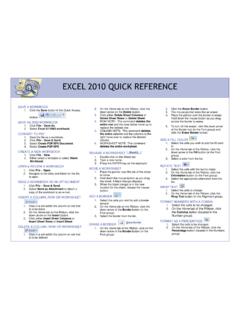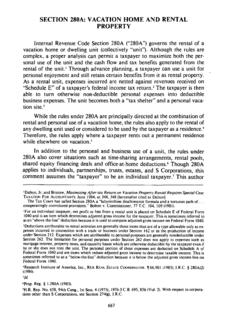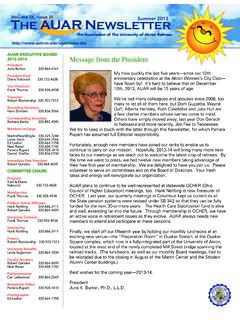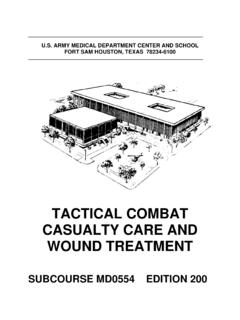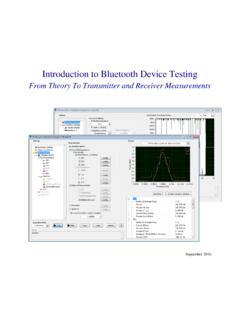Transcription of INTRODUCTION TO MAP READING - University of Akron
1 Section4 Key Points1 Marginal Information2 Topographic Symbols3 Terrain Features4 Determining Four- and Six-Digit Grid CoordinatesINTRODUCTION TOMAP READINGT actics andTechniques TrackWith our military forces dispersed throughout the world, itis necessary to rely on maps to provide information toour combat elements and to resolve logistical operationsfar from our shores. Soldiers and materials must betransported, stored, and placed into operation at theproper time and place. Much of this planning must bedone using maps. All operations require a supply ofmaps; however, the finest maps available are worthlessunless the map user knows how to read 8/19/08 10:58 AM Page 178 Tactics andTechniques TrackIntroductionIn Section 1, you learned how to navigate using information from a civilian-style mapand a compass.
2 In doing so, you learned that in order to navigate accurately, the mapis one of your most important pieces of equipment. In this section, you will examine amilitary map, study its parts, and learn more about its uses. To be safe in a battle zone,you must know how to read a map, plot your location, and move in the rightdirection. If you can t navigate correctly, you risk getting lost or worse, stumbling intodangerous territory. Consider the experience of MAJ Robert K. Wright Jr., historian forXVIII Airborne Corps. MAJ Wright accompanied the Corps in Operation Just Cause, theAmerican liberation of Panama in 1989. Lost in PanamaI had one last interview to do on [January] 13th[, 1990].
3 So I went over and gotthat interview; they were off at a different location, so I'd gotten a driver to takeme over, and I got one of their drivers to take me back to Fort Clayton, to thebattalion headquarters. And I'd really gotten to know that battalion .. very, verywell while I was down there. So I asked the S-3 could he get me a ride to theairport. So he gave me an NCO and a driver and a 'Hummer' [HMMWV; M-998-series High Mobility Multi-Wheeled Vehicle] and said Sure, just take the Doc out. So we swung by, picked up my gear. I cleared post. And off we went. And we'redriving and driving and driving, and I know it isn't that far. Plus, we're goingthrough the jungle.
4 We're going up a paved highway and everything, but passingtraffic and whatnot, which is taking forever. And then we went past this one areaand I recognized it from aerial recon that I had done in the helicopter photographymissions this was Cerro Tigre, the PDF [Panamanian Defense Force] supply was about 120 degrees in the wrong direction from the airport. So at that point I casually inquired of the driver Do you know where we'regoing? And he said, Why no, sir, I thought you knew where we're going. And Iturned around and looked at the NCO, and he said Don't look at me, I don'thave a map either. So I said Oh, , well, hang a right and we'll keep goinguntil we find the ocean or something and we get oriented.
5 And we literallywandered around. And I remembered thinking at the time, yeah, I've got seven rounds in my .45 .. So here we are, traveling through the countryside and had .. I mean, wewere out in the boonies. And had there been a disgruntled PDF guy still runningaround loose, it was me and my seven rounds from the .45, and that's all we hadto protect us. Department of the Army, XVIII Airborne CorpsIntroduction to Map READING 1798420010_TT4_p178-197 8/19/08 10:58 AM Page 179 Marginal InformationThe Army defines a map as a graphic representation of a portion of the earth s surfacedrawn to scale, as seen from above. Because the map is a graphicrepresentation, you ll need a written explanation of thegraphic elements.
6 You ll find that explanation in the margins of the map: the marginalinformation. (Chapter 3 of FM explains all the marginal information in detail.) 180 SECTION 4 Critical ThinkingWhat mistake did MAJ Wright, his driver, and the NCO make? Who wasresponsible for the mistake: MAJ Wright, the driver, or the NCO?eFigure Representation of the Earth s Surface8420010_TT4_p178-197 8/19/08 10:58 AM Page 180 INTRODUCTION to Map READING 181legendthe section on a mapthat contains thesymbols you need toread the mapFigure Bottom of a MapFigure LegendThe map legendidentifies the symbols used to depict the prominent natural and man-made objects that exist on the ground.
7 These symbols are not the same on every map,especially foreign maps. Check the legend to avoid making serious mistakes. The legendfrom the bottom of the map in Figure is shown enlarged in Figure sheet name and numberprovide the title and the reference number for the usually take their sheet names from the largest settlement or natural feature on themap. For example, the Tenino Map includes the community of Tenino, sheet number is in bold print in the upper right and lower left areas of the margin(Figures and ). At the lower right margin on the map is a diagram that showsadjoining map sheets. Your map sheet will always be depicted in the center of this will learn later in your military studies how to link adjoining map sheets to operationaloverlays, operation orders, and operation 8/19/08 10:58 AM Page 181 The scalegives you the ratio of the distance on the map to the distance on the example, a scale of 1:50,000 (Figure ) indicates that one unit of measure on the mapequals one unit of measure on the ground.
8 In other words, one inch on the map equals50,000 inches on the ground, or approximately 8/10ths of a mile or kilometers. Thelarger the ratio, the less detail can be placed on the map. Likewise, the smaller the ratio,the more detail can be placed on the map. Therefore, a 1:25,000 map will have largergrids, allowing the map-printing agency to place more details onto the contour interval, also found in Figure , specifies the vertical distance betweencontour lines. The contour interval for each map will be listed in the lower center of themap margin. Make sure you note whether the interval is in meters or SECTION 4scalethe ratio of the mapdistance to thecorresponding distanceon the earth s surfaceFigure The Three NorthsFigure Scale, Contour Interval, and Grid Reference Box8420010_TT4_p178-197 8/19/08 10:58 AM Page 182 The declinationdiagramdepicts the three norths on your map:true north,magneticnorth, and grid north(Figure ).
9 The declination diagram also lists the grid to magneticangle (G-M angle) in degrees. The G-M angle is the angular difference between grid northand magnetic north. The closer to the poles you go, the greater this angle the G-M angle is critical. In order to use a grid map and compass to navigate,you must know how to convert a magnetic azimuth from your compass to a grid azimuthonto your map (or vice versa). You ll learn more about azimuths in the next adjoining sheets diagramtells you the sheet numbers of the adjoining sheets ( ). You ll see a checkerboard-like display with the square in the center of the displayrepresenting the map you are READING .
10 For example, if you need the map to the east of themap you re READING , look at the adjoining sheets diagram, identify the sheet number ofthe adjoining map, and request the notestell you among other things the references the mapmakers have used indetermining vertical and horizontal distances and the agencies responsible for the have divided the world into 60 grids and given those grids short letter-and-number (alpha-numeric) designators called grid zone designators. The grid zonedesignator for your map sheet is located at the bottom center of the map inside the gridreferencebox (Figure ). The information in this box gives you the grid zone designationand the 100,000-meter square identification for your map sheet.




